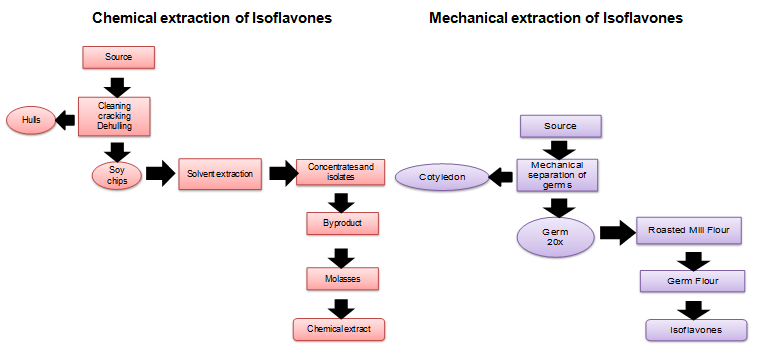Isoflavones Market Future Outlook - Analyst view
Isoflavones compounds & extracts were initially discovered owing to their ability to disrupt the function of estrogen in animals. They belong to the class of organic compounds & biomolecules, and are classified as the members of flavonoid family. Flavonoid is a member of plant constituents known as polyphenols. These phytoestrogens are naturally occurring plants chemicals with estrogen-like properties.
Major sources for obtaining isoflavones are soybeans, peas, beans, red clover and other plant sources. Globally, soy is the major source of extracting isoflavones. The concentration of isoflavones in its sources depends on the genetics, environment in which the plant was grown, and the processing technology used. The isoflavones content in soybeans and its products vary from 470 to 4216 micrograms per gram of soy. This range of content depends on the variety, location, growing conditions, and stress on the plant.
There are two methods to derive the isoflavones from its sources. One is chemical and other is mechanical. Chemical extraction is a conventional process, in which sources are converted into concentrates and isolates by using solvents. These concentrates and isolates then generate a byproduct referred as molasses, which are a rich source of isoflavones. Earlier, aqueous acid or alcohols were used to remove water-soluble materials from the source. These water-soluble materials contained a large portion of isoflavones.

In the mechanical extraction of isoflavones, the germ from the sources is mechanically separated from cotyledons. These germs contain 5 to 6 times more isoflavones than rest of the bean. Once the isoflavone is extracted from its sources, it is then isolated and purified using different methods. Various researches are going on for developing new and improved methods for extraction and isolation of isoflavones from its sources. Companies are also trying to develop isoflavones from new sources such as iris potaninii (species in the genus Iris, a dwarf plant).
Isoflavones are believed to be one of the strong antioxidants. They are mostly used in reducing heart disease, bone problems, high blood pressure & cholesterol. It is also beneficial for asthma, diabetes, multiple cancer (such as endometrial cancer. lung cancer, thyroid cancer, prostate cancer), and slowing the progression of kidney disease. These extracts are believed to be a beneficial cure for preventing breast cancer, hot flashes after breast cancer, premenstrual syndrome (PMS), and menopausal symptoms.
Isoflavones based nutraceutical & dietary supplements are gaining popularity in western countries. Soybeans, red clover and other sources of isoflavones are not consumed in the daily diet of these countries. With the growing population and rising health concern consumers are focusing more on consumption of naturally derived products. Consumers are more interested in consuming supplements products which provide them various health benefits.Due to various advantages of isoflavones in nutraceutical, food & beverage and cosmetics industries, the need for the product is expected to grow in the near future.
 In-depth report on global isoflavones market by Grand View Research:
In-depth report on global isoflavones market by Grand View Research:
https://www.grandviewresearch.com/industry-analysis/isoflavones-market